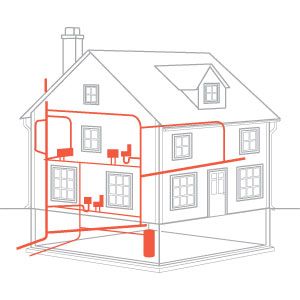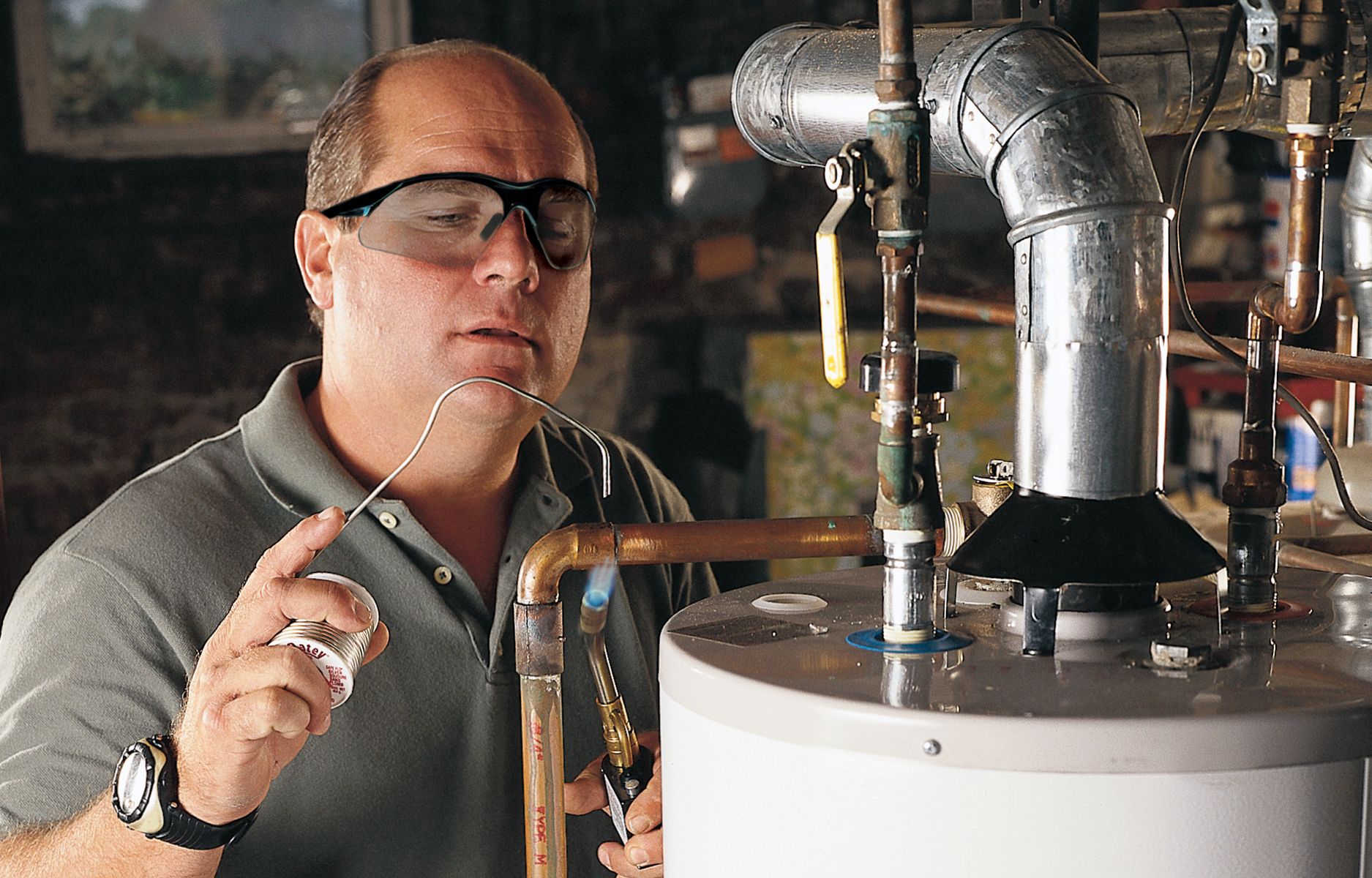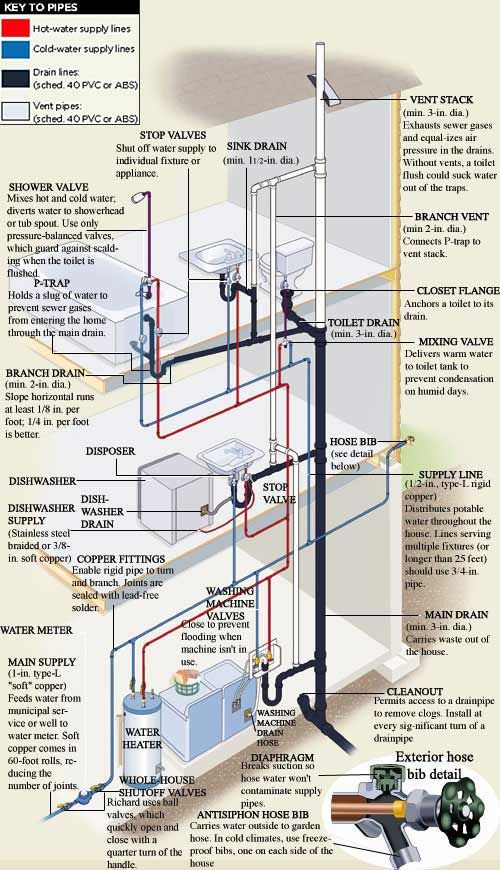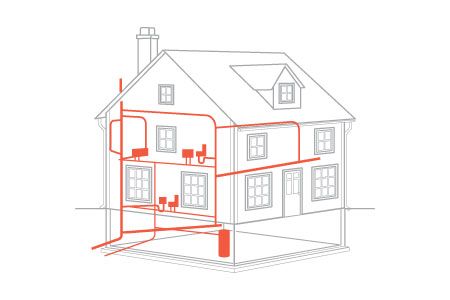Plumbing is an unseen but critical part of your home. This complex network of pipes, fixtures, and appliances works to remove waste and deliver clean water, helping you to meet your daily needs and keep your home functional.
Whether you’re building a new house or maintaining an existing one, taking time to understand your home’s plumbing system can help you make key decisions and spot potential issues. Our guide breaks down the essentials of residential plumbing, including the basic components plus advanced technologies and best practices.

Understanding Your Home’s Plumbing System
Your home’s plumbing system is composed of three main systems: the supply line network, the drainage system, and the venting system. Each plays a crucial role in keeping water running in and out of your home.
Supply Line Network
The supply line network brings clean water into your home from the municipal water supply or a private well. This system operates under pressure to deliver water to all of the different fixtures and appliances throughout your house. It ensures that multiple fixtures can function simultaneously, maintaining sufficient water flow and pressure throughout the home.
Supply lines are usually made of copper or cross-linked polyethylene (PEX).
Drainage System
The drainage system carries wastewater and sewage away from your house. Unlike supply lines, drain pipes rely on gravity to move water. These pipes are larger in diameter and are typically made of polyvinyl chloride (PVC) or acrylonitrile butadiene styrene (ABS) plastic in modern homes, though older homes may have cast iron drains.
Because the drain system relies on gravity, drain pipes usually must be sloped. Generally, drain pipes should have a slope of one-quarter of an inch per foot to facilitate the proper flow of wastewater. This slope helps prevent clogs and ensures that waste materials move smoothly through the pipes toward the main sewer line or septic system.
Vents
Vent pipes allow air to enter the drainage system, preventing vacuums from forming that could slow or stop water from flowing down your drain lines. Proper venting ensures that each fixture has its own air supply, which you need to prevent losing water seals in plumbing traps under your sinks and toilets, preventing sewer gases from entering your home.
As This Old House plumbing expert Richard Trethewey explains, “When you pull the plug on a bathtub, you’ve got 40 gallons of water that wants to scream down that pipe. If there’s a vacuum, it can pull the water out of all the traps in the house.”

Components of Your Plumbing System
Modern plumbing systems rely on several components that work together to maintain efficient water distribution and waste removal.
Pipes and Fittings
Pipes are the highways of your plumbing system, carrying water to and from fixtures. Fittings connect pipes, change direction, or adapt pipe sizes. Common materials for pipes include copper, PVC, PEX, and ABS. Each material has specific fittings designed to ensure secure, leak-proof connections.
Fixtures and Appliances
Fixtures are the end-points of your plumbing system—think sinks, toilets, showers, and bathtubs. Appliances like dishwashers and washing machines also connect to your plumbing. Modern fixtures often incorporate water-saving features to promote conservation. For example, dual-flush toilets and low-flow showerheads can significantly reduce water usage without compromising performance.
Valves and Shutoffs
Valves control water flow within your plumbing system. The main shutoff valve can stop water flow to the entire house, while individual fixture shutoffs allow for isolated repairs. “Individual shutoffs allow you to quickly isolate a problem without cutting the water supply to the rest of your house,” says Tretheway. Your system needs this ability to control water flow at various points so you can perform maintenance and repairs without disrupting the entire household.

Choosing the Right Materials for Your Plumbing
Different parts of your plumbing system may require different materials based on their specific functions and local building codes.
PVC vs. ABS for Drains
Both PVC and ABS are popular choices for drain pipes. PVC is more flexible, while ABS is more impact-resistant. The choice often depends on local codes and personal preference, as both perform well in residential applications.
Copper vs. PEX for Supply Lines
Copper has been popular for water supply lines for decades due to its durability and natural antimicrobial properties. However, PEX has gained popularity for its flexibility, ease of installation, and freeze-resistance. PEX is often less expensive than copper and can be a good choice for new construction or repiping projects. PEX’s flexibility allows it to be snaked through walls and around obstacles without the need for multiple fittings, reducing potential leak points.
Cast Iron for Plumbing
While less common in modern construction, cast iron still has its place in plumbing. It’s excellent for reducing plumbing noise in vertical drain stacks and is often required in commercial buildings. In residential settings, cast iron might be used for main sewer lines or in situations where you want extra durability or sound dampening. Its robust nature can handle heavy usage and resist damage, making it ideal for high-traffic areas or where long-term performance is a priority.
Planning Your Plumbing Layout
A well-planned system can save considerable water and energy. Consider these factors when designing your plumbing layout.
Efficient Fixture Placement
Grouping fixtures and appliances that use water can significantly reduce the amount of piping needed and improve efficiency. For example, placing the kitchen, laundry room, and bathrooms close to each other or stacked in multi-story homes can minimize pipe runs and reduce heat loss in hot water lines. This placement also simplifies the overall plumbing layout, reducing complexity and cost.
Direct Pipe Runs
Shorter pipe runs not only save on material costs but also improve water pressure and reduce heat loss in hot water lines. When planning your layout, aim to create the most direct routes possible between the water heater and fixtures, while still allowing for proper slope in drain lines. This approach ensures that water is delivered rapidly and efficiently, enhancing the overall performance of the plumbing system.
Future Expansions
Planning for future expansions can save significant time and money if you decide to renovate or add to your home later. Having foresight in the early stages of design allows for easier integration of new fixtures and systems without the need for extensive rework.
Plumbing Installation Best Practices
Following these best practices ensures your plumbing is installed correctly and will perform well for many years.
Proper Pipe Support and Anchoring
Pipes need to be properly supported to prevent sagging, which can lead to poor drainage or stress on joints. Use appropriate hangers and straps, spacing them according to local codes and manufacturer recommendations. Tretheway notes, “Supply pipes that aren’t anchored every six feet or so will rattle and thump every time a faucet is turned off.” Proper support ensures that pipes remain stable and secure, reducing the risk of leaks or damage.
Creating Accessible Cleanouts
Cleanouts provide access points for clearing clogs and inspecting pipes. Install cleanouts at key locations, such as where the main drain exits the house, at the base of vertical stacks, and where drain lines change direction. Check that cleanouts are easily accessible for future maintenance. Having these access points makes it easier to perform routine maintenance and address issues without extensive disassembly of the plumbing system.
Insulating Pipes for Energy Efficiency
Insulating hot water pipes reduces heat loss, saving energy and allowing you to lower your water heater temperature. In cold climates, insulating both hot and cold water pipes can prevent freezing. Use appropriate insulation materials and ensure all exposed pipes are covered, especially in unheated areas. Proper insulation not only enhances energy efficiency but also protects against potential damage from temperature extremes.
Common Plumbing Mistakes To Avoid
Even experienced DIYers can make plumbing mistakes that lead to leaks, inefficiencies, or code violations. Be aware of these common pitfalls.
Improper Slope in Drain Lines
Drain lines require a proper slope to function correctly. Too little slope can lead to standing water and clogs, while too much slope can cause water to outrun solid waste. The general rule is a one-quarter inch drop per foot of horizontal run for drain pipes three inches or larger in diameter. Having the correct slope helps maintain an efficient flow of wastewater, reducing the risk of blockages and backups.
Mixing Different Pipe Materials
While it’s sometimes necessary to connect different types of pipes, improper connections can lead to leaks or system failure. Always use the correct fittings and methods when transitioning between materials, such as copper to PEX or PVC to ABS. Using the appropriate transition fittings and adhering to best practices helps maintain the integrity of the plumbing system and prevents leaks.
Inadequate Venting
Proper venting is crucial for drain performance and preventing sewer gases from entering your home. Each fixture needs to be properly vented, and vent pipes must be the correct size and configuration. “Codes dictate the proximity of vents to drains, and the rules should never be ignored,” says Tretheway. Proper venting maintains the balance of air pressure within the plumbing system, preventing issues such as slow drainage and unpleasant odors.
Troubleshooting Plumbing Issues
Even well-maintained plumbing systems can develop problems over time. Being able to identify and address common issues can save you time and money on repairs.
Identifying Leaks
Leaks can occur in various parts of your plumbing system and may not always be obvious. Look for signs such as water stains, mold growth, or unexplained increases in your water bill. For hidden leaks, turn off all water-using appliances and check your water meter. If it’s still moving, you likely have a leak. Early detection and repair of leaks prevents water damage and reduces water waste.
Dealing with Clogs
Clogs are a common plumbing issue that can often be resolved without calling a professional. For minor clogs, try using a plunger or drain snake. Avoid chemical drain cleaners, as they can damage pipes and are harmful to the environment. For persistent clogs, it may be time to call a professional. Regular maintenance, such as using drain screens and avoiding disposing of grease or large food particles down the sink, can help prevent clogs. Watch the video below to learn how to deal with clogs in your home. To learn more, check out our guide on how to unclog any drain.
Addressing Low Water Pressure
Low water pressure can have a lot of different causes, including mineral buildup in pipes, partially closed valves, or municipal supply issues. Check that your main shutoff valve is fully open, and inspect visible pipes for signs of leaks. If the problem persists, consult a professional plumber. Low water pressure not only affects the functionality of fixtures but can also indicate underlying issues.
Plumbing Maintenance Tips for Longevity
Regular maintenance is key to keeping your plumbing system in top condition and preventing costly repairs. Use our tips to extend the life of your plumbing and catch potential issues before they become major problems.
Regular Inspections
Visually inspect your plumbing regularly, looking for signs of leaks, corrosion, or damage. Pay special attention to areas under sinks, around toilets, and in basements or crawl spaces. Annual professional inspections can catch issues you might miss and provide peace of mind. Regular inspections help identify small problems before they escalate into more significant, expensive repairs.
Cleaning Drains and Aerators
Regularly cleaning drains and faucet aerators can prevent clogs and improve water flow. Use a mixture of baking soda and vinegar followed by hot water to clean drains naturally. Remove and clean faucet aerators annually to prevent mineral buildup.
Protecting Pipes from Freezing
A frozen pipe bursting can cause significant damage. Insulate pipes in unheated areas, seal leaks that allow cold air inside, and let faucets drip slightly during freezing weather.
When To Call a Professional Plumber
Plumbing codes cover everything from pipe materials and sizes to venting requirements and fixture installation. Adhering to local codes helps ensure your plumbing system complies with safety and performance standards.
While many minor plumbing tasks can be DIY projects, complex installations or major repairs often require professional expertise. Always consult a licensed plumber for jobs that involve gas lines, main sewer lines, or required permits. Professional plumbers have the knowledge, experience, and tools to handle complex plumbing tasks safely. Learn more about the cost of hiring a plumber in our guide, How Much Does Plumbing Cost?
Our Conclusion
Plumbing jobs are intricate. Keep detailed records of all plumbing work done in your home, including permits, inspections, and receipts for materials and labor. This documentation can be valuable for future maintenance, repairs, or a home sale. Proper documentation gives a clear history of your plumbing system, which can be useful for resolving issues and verifying compliance with local codes.
Remember, while many plumbing tasks can be DIY projects, don’t hesitate to call in a professional for complex issues or when in doubt. See our guide on how to find and hire a qualified plumber.

